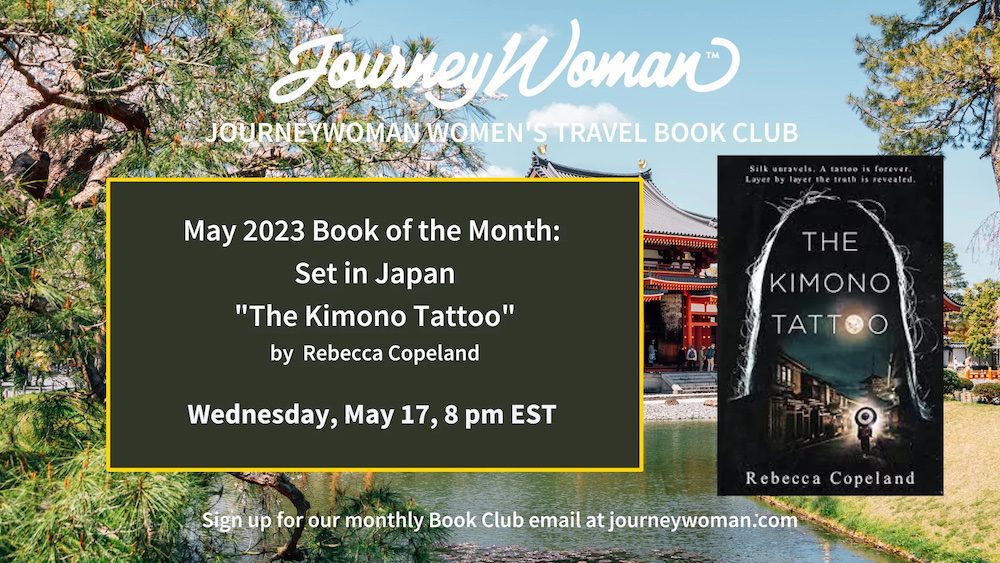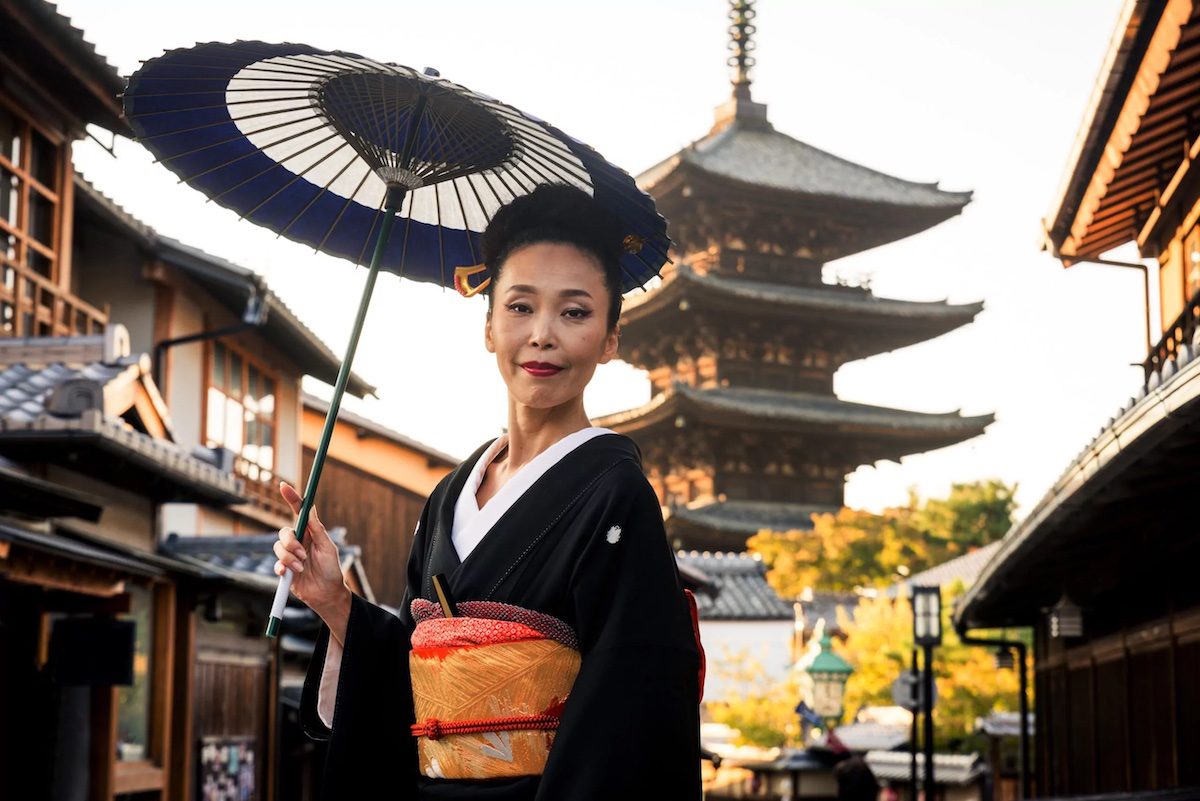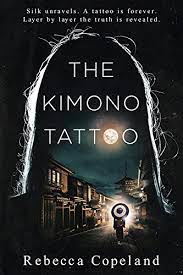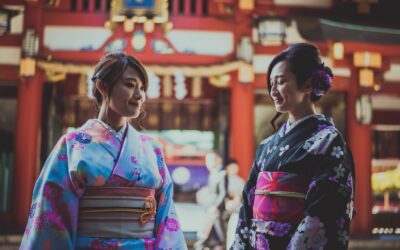Last updated on November 19th, 2023
Featured image: Woman in a kimono walking at Yasaka Pagoda in Kyoto by oneinchpunchphotos
Making Japanese culture accessible to everyone
By Carolyn Ray, Editor, JourneyWoman
In the new thriller ‘The Kimono Tattoo’, fictional dangers become real when an American translator Ruth Bennett is asked to translate a mysterious novel. Using her skills as a translator and her intimate knowledge of both kimono and Kyoto, Ruth is forced to confront a vicious killer along with her own painful family secrets.
In writing the book, Dr. Rebecca Copeland says she wants readers to feel like they have been to Kyoto and make Japanese culture accessible to everyone. In our latest survey, Japan ranked #3 on our list of places women want to explore in 2023.
“I want readers to see that Japan is not such a mysterious place,” Copeland says. “Even though the novel is a mystery, the characters in it are just normal people—more or less. (Tokuda is pretty extraordinary!) And Ruth, as our guide, is pinned between the US and Japan. She’s an imperfect guide. She makes mistakes in both cultures. And that’s okay. It’s okay to make mistakes. It’s okay to be an outsider. What’s important is to try to learn, to try to read the signs.”
Click Here to Buy or Download "The Kimono Tattoo"
Buy now on Bookshop.org
Buy now on Amazon/Audiobooks
You can help support our Book Club: When you purchase a book using the links on our site, JourneyWoman receives a small commission from the bookseller. This is one of you ways you can help us maintain our beautiful website and editorial content.
Dance plays an important role in the book, as do kimonos and Japanese culture. Copeland was born in Japan but moved to the States when she was only 3 weeks old. She returned in her 20s, and through dance lessons, was able to learn the culture.
“The way dance is taught in Japan (and this is true of other arts) is through modeling,” Copeland says. “It’s called “mi-narai” (learn through your eyes). My teacher would show me and the other student (an American woman who had better Japanese) the dance move. We then tried to imitate what she did, over and over. In this way, we learned (through our eyes but also through our bodies). And I found that dance became a language for me. Dances themselves tell stories or channel emotions. In a way, dance is a form of translation.”
For me, dance and kimonos are inextricably linked,” she says. “Both operate on the level of discourse. They tell stories. To practice dance I had to learn how to wear a kimono. My dance teacher lent me a practice garment—a cotton kimono known as a yukata. Midway through my lessons, my mother (who was also in Japan with me), bought me a new (but inexpensive) kimono and formal sash. My teacher taught me how to wear it, fold and store it, and appreciate it. I hadn’t intended to write about kimonos or dance in The Kimono Tattoo. My initial plan was to write about a translator who begins translating the story of a murder, only to find a real murder taking place outside the world of fiction. As I was writing, though, the kimono angle appeared. And with kimonos, came dance!”
Balancing the beauty of the kimono with Kyoto’s underground
“Silk unravels. A tattoo is forever. Layer by layer the truth is revealed.”
In The Kimono Tattoo, Copeland also wants readers to appreciate the beauty of the kimono —not as some kind of moribund garment of yesteryear—but as a living, dynamic, flexible aspect of contemporary material culture.
“We can all wear kimonos,” she says. “I wanted the story to unfold like a kimono. I wanted it to change meaning as the layers came off. And if you ever go to Kyoto, you can rent a kimono for the day and try out walking around in one. The rental shop will dress you! (https://www.okamoto-kimono-en.com/ )
She also wanted to represent something dark. In this case, the storyline of Ruth’s brother Matthew, who was abducted as a child in the novel.
“I don’t want Japan to seem like just a land of eternal beauty,” she says. “It has a very dark underside as well. Women, particularly non-Japanese women from less-wealthy countries, are exploited in the sex trade in Japan. Because of the Matthew angle, I needed the darkness to involve children.
The Japanese sex trade has exploited women from under-developed countries, promising them work if they come to Japan and then trapping them in slave-like conditions. (Once Japan’s economy tanked, some of these practices ended, but it’s still happening. Young men are trapped, too, often in restaurants, construction, and other low-end jobs.) Women from more wealthy countries sometimes find themselves getting involved emotionally with psycho-men in Japan who then harm them.”
About Author Dr. Rebecca Copeland
Dr. Rebecca Copeland is a professor of Japanese language and literature at Washington University in St. Louis. Her research specialties include modern and contemporary women’s writing in Japan, modern literature, and translation studies. Dr. Copeland also writes fiction and just published her first novel called The Kimono Tattoo (Brother Mockingbird). A writer of fiction and literary criticism and a translator of Japanese literature, Coepland’s stories travel between Japan and the American South and touch on questions of identity, belonging, and self-discovery.
This book took her 10 years to write, and she says it was a learning experience. Copeland did most of the writing in the summers, during visits to Japan, in 2012, 2013, 2015, and 2017.
“Each time I returned to the novel, it was like a great homecoming,” she says. “I was happy just to tinker around with it. The only time I almost lost heart was in 2018 when it looked like I just wasn’t going to get an agent. My inquiry letters were often successful, and I’d get asked for the manuscript. But then the agents always came back with: “I liked it, but I don’t know how to represent it.” Again and again. They never offered advice. They just said, “good luck.” So, I started to lose heart. It went into production in 2020 and was released in 2021.”
“I’ve been trying to write the next novel—a follow up to The Kimono Tattoo—and I’ve not been able to get very far,” she says. “I can’t write creatively when I’m deep in my academic work. I just can’t parcel my brain out like that, and I admire people who do! Since The Kimono Tattoo was published in 2021, I’ve published an academic book and completed some other academic projects, and I realize I just can’t do both at once. I’m hoping this summer, though, I can return to Ruth.
Read more about editing The Kimono Tattoo here.
Read More: Rebecca’s Tips for Your First Trip to Kyoto

Rebecca Copeland dancing, provided by the author. Learn more on her website.

Book Club Discussion Questions
Join us for our May 17 Book Club discussion at 8 pm ET. Bring your favorite tea, wear your kimono and learn mor about Japanese culture.
We may not get through all of these, but here are some thoughts to start our discussion!
- Have you travelled to Kyoto or anywhere else in Japan? Did anything about the book’s setting feel familiar? Why, or why not?
- What was your favourite passage in the book, and why?
- Did you learn anything about kimonos in particular, or Japanese culture in general, that surprised you?
- The art of the kimono is central to the plot of the novel. There is also a strong presence of other arts, such as dance, tattooing, and calligraphy (with an emphasis on the meaning of the characters). Have you read any other works of fiction where a specialised skill, craft or art plays as strong a role in the narrative?
- The author also uses kimono imagery, both literally and figuratively, to develop and describe her characters. Can you think of any examples where she does this?
- Ruth’s department chair didn’t consider her Japanese-to-English translations to be original work, worthy of academic distinction. Have you read books in translation? Have you ever thought about what value a skilled translator might bring to the story?
- Ruth travels about the city using buses, trains, and taxis. When you travel, how do you choose to move from place to place, within and between cities? How did her descriptions of public transportation compare with the systems in your home countries or places you’ve visited?
- Maho talks about her own experience of tattooing: how she has tried to explain to her parents that tattoos are a way to release her inner self, how Satoko’s tattoos could have been an expression of self-love, and how the pain of the process is a kind of language. Do you (or does someone close to you) have tattoos? Do either the designs or the procedure have any personal significance?
- The manuscript delivered to Ruth uses various storytelling devices, from diary entries to letters to first-person narrative. What effects do these different forms have on reading a story? Do you think that’s the reason the writer of the mysterious manuscript used them?
- Ruth feels simultaneously both very at home in Japan and visibly a foreigner. How does this affect her interactions with those around her? Have you found that your identity as a foreigner has affected how others treat you on your travels?
- At the end of the story, Ruth returns to a particular pillar at the Nanzen Temple where she and her brother had played as children. Have you ever returned to a childhood landmark and noted how it has changed with the passage of time, or how different it seems from your perspective as an adult?
- Did the book make you want to travel to Japan?
Click Here to Buy or Download "The Kimono Tattoo"
Buy now on Bookshop.org
Buy now on Amazon/Audiobooks
You can help support our Book Club: When you purchase a book using the links on our site, JourneyWoman receives a small commission from the bookseller. This is one of you ways you can help us maintain our beautiful website and editorial content.
Featured articles on Asia
Solo Travel Tips for Japan for Women 50+
For your next trip to Japan, have a small change purse ready, practice bowing and other travel tips from women who have been there.
Getting Naked (or Not) With Strangers: When and Where to Take Your Clothes Off in Asia
Sandra Phillips breaks down the etiquette of getting naked (or not!) during Asian wellness experiences in Japan, China, and Thailand.
30 Less-Travelled Places for Women in 2024
For our 30th anniversary, JourneyWoman reveals 30 less-travelled places for women in 2024, according to our writers and travel experts.








I just now realized this event and am very excited about it.
I lived in Japan from 1981-1995. I went alone with no language, no job or friends, little money,
but with a desire for adventure, huge curiosity, and a love of Asian art. I was 40 yrs. of age.
It was difficult for many reasons but I persisted. I lived in Kyoto, Osaka, and Kobe. In 1995 I became a
very fortunate survivor of the Kobe Hanshin earthquake. Many friends tragically died. I became homeless.
A month later I returned to the States. My huge kimono and obi collection followed. They continue to take up a large part of my small apt. Looking at them fills me a river of emotions.
Thank you doomo arigatou gozaimasu,
Warmly,
Elaine